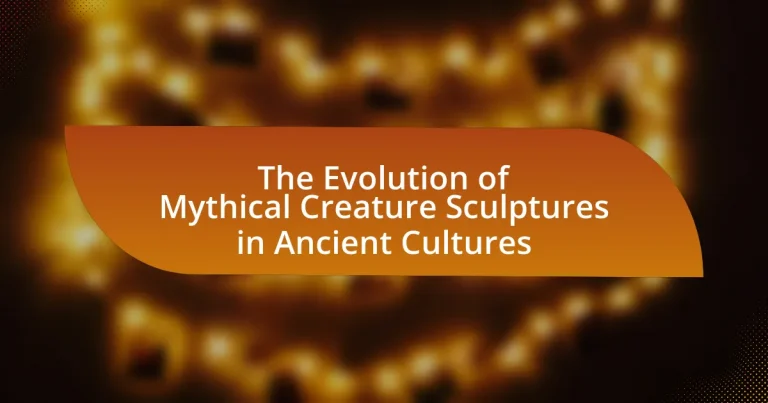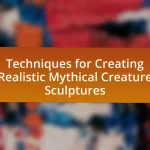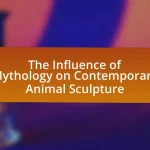Mythical creature sculptures in ancient cultures are artistic representations that combine human and animal features, reflecting the beliefs, values, and narratives of those societies. These sculptures served various purposes, including religious rituals, storytelling, and symbols of power or protection. The article explores how ancient cultures defined mythical creatures, the materials and techniques used in their creation, and the significance of these sculptures in religious practices and social functions. It also examines the evolution of these sculptures influenced by historical factors, trade, and technological advancements, highlighting key examples from different civilizations and their interpretations of mythical beings.
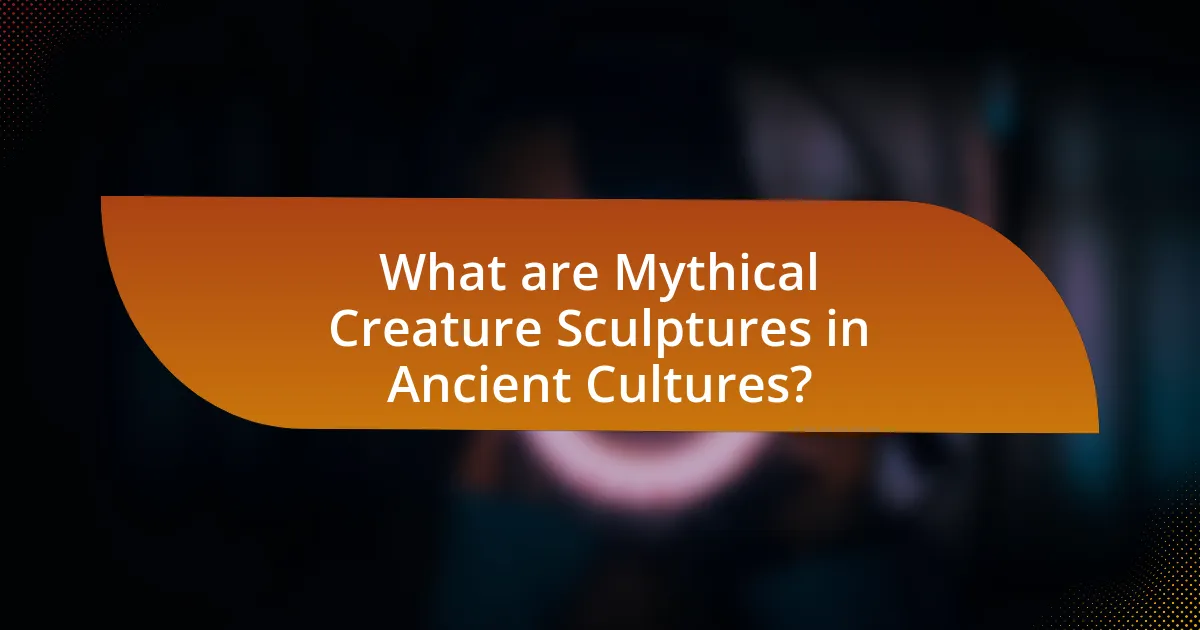
What are Mythical Creature Sculptures in Ancient Cultures?
Mythical creature sculptures in ancient cultures are artistic representations of beings that combine human and animal features, often embodying the beliefs, values, and narratives of those societies. These sculptures served various purposes, including religious rituals, storytelling, and as symbols of power or protection. For instance, the griffin, a creature with the body of a lion and the head and wings of an eagle, was prevalent in ancient Mesopotamia and symbolized divine power. Similarly, the sphinx in ancient Egypt, with its lion body and human head, represented strength and wisdom. Such sculptures not only reflect the artistic styles of their time but also provide insight into the cultural significance of mythical beings in ancient civilizations.
How did ancient cultures define mythical creatures?
Ancient cultures defined mythical creatures as beings that combined human and animal traits, often embodying the values, fears, and beliefs of those societies. For instance, the ancient Egyptians depicted gods like Anubis, who had a human body and a jackal head, symbolizing their beliefs in the afterlife and protection. Similarly, Greek mythology featured creatures such as centaurs, which represented the duality of human nature, combining the intellect of humans with the strength of horses. These definitions were often reflected in art and literature, serving as a means to convey moral lessons, cultural narratives, and the supernatural elements of their worldviews.
What characteristics distinguish mythical creatures from real animals?
Mythical creatures are distinguished from real animals primarily by their supernatural attributes and origins. Unlike real animals, which are biologically classified and exist within the natural world, mythical creatures often possess extraordinary abilities, such as flight, shape-shifting, or immortality, and are frequently rooted in folklore or mythology. For example, dragons, which are often depicted as fire-breathing and capable of flight, do not exist in the biological classification of animals. Additionally, mythical creatures are typically symbolic, representing cultural beliefs or moral lessons, whereas real animals do not carry such allegorical meanings. This distinction is evident in ancient cultures, where sculptures of mythical beings, like griffins or centaurs, were created to convey specific narratives or values, unlike sculptures of real animals that aimed to represent their physical forms accurately.
Why were mythical creatures significant in ancient belief systems?
Mythical creatures were significant in ancient belief systems because they embodied cultural values, explained natural phenomena, and served as symbols of human experiences. These creatures often represented the intersection of the divine and the earthly, allowing societies to articulate their understanding of the world around them. For instance, in ancient Mesopotamia, the Lamassu, a winged bull with a human head, symbolized protection and served as a guardian at city gates, reflecting the importance of security in urban life. Similarly, in Greek mythology, creatures like the Minotaur represented the complexities of human nature and societal fears, illustrating how these beings were used to convey moral lessons and cultural narratives.
What materials were used in the creation of these sculptures?
The materials used in the creation of mythical creature sculptures in ancient cultures included stone, metal, clay, and wood. Stone was often utilized for its durability, with examples like marble and granite being favored in Greek and Roman sculptures. Metal, particularly bronze, was commonly used for its malleability and strength, allowing for intricate designs. Clay served as a primary medium for smaller sculptures and figurines, especially in Mesopotamian and Egyptian cultures, while wood was used for totemic and ceremonial pieces in various indigenous cultures. These materials reflect the technological capabilities and artistic preferences of the respective cultures, as evidenced by archaeological findings and historical records.
How did the choice of materials reflect cultural values?
The choice of materials in mythical creature sculptures reflected cultural values by showcasing the significance of available resources and the symbolic meanings attributed to those materials. For instance, ancient cultures often utilized locally sourced stone, wood, or metal, which indicated a deep connection to their environment and the importance of sustainability. In Mesopotamia, the use of clay for sculptures symbolized fertility and creation, aligning with the region’s agricultural values. Similarly, in ancient Egypt, the preference for durable materials like granite and basalt in sculptures represented the culture’s emphasis on permanence and the afterlife, as these materials were believed to ensure the longevity of the depicted deities. Thus, the selection of materials not only served practical purposes but also conveyed the underlying beliefs and priorities of the respective cultures.
What techniques were employed in sculpting mythical creatures?
Techniques employed in sculpting mythical creatures included carving, modeling, and casting. Carving involved removing material from stone or wood to create detailed forms, as seen in ancient Greek sculptures of centaurs and griffins. Modeling utilized malleable materials like clay to shape figures, allowing for intricate designs and textures, evident in Mesopotamian artifacts depicting mythical beings. Casting, particularly in bronze, enabled the replication of complex shapes and was widely used in ancient China for dragon sculptures. These methods collectively contributed to the rich artistic traditions surrounding mythical creatures in various ancient cultures.
What roles did mythical creature sculptures play in ancient societies?
Mythical creature sculptures served multiple roles in ancient societies, primarily as symbols of power, protection, and cultural identity. These sculptures often adorned temples and public spaces, signifying the divine or supernatural authority of rulers and deities. For instance, the griffin, a common motif in ancient Near Eastern art, represented strength and vigilance, often placed at entrances to ward off evil. Additionally, these sculptures played a crucial role in storytelling and mythology, helping to convey cultural narratives and values. Evidence from archaeological sites, such as the lion-headed figures in Mesopotamia, illustrates their significance in rituals and as offerings to gods, reinforcing their importance in both religious and social contexts.
How were these sculptures used in religious practices?
Sculptures of mythical creatures were integral to religious practices as they served as representations of deities, symbols of protection, and focal points for worship. In ancient cultures, these sculptures were often placed in temples or sacred spaces, where rituals and offerings were made to invoke the favor of the represented beings. For instance, in ancient Egypt, sculptures of gods like Anubis were used in burial practices to guide the deceased in the afterlife, while in Mesopotamia, statues of protective deities were placed at city gates to ward off evil. These practices highlight the belief that the physical presence of these sculptures could facilitate communication with the divine and ensure spiritual safety.
What social functions did they serve within communities?
Mythical creature sculptures served as vital social functions within communities by embodying cultural beliefs, facilitating social cohesion, and acting as symbols of power or protection. These sculptures often represented deities or mythological narratives that reinforced shared values and traditions, thereby fostering a sense of identity among community members. For instance, in ancient Mesopotamia, sculptures of mythical beings like Lamassu were placed at city gates to protect against evil and signify the strength of the city, illustrating their role in both spiritual and civic life.
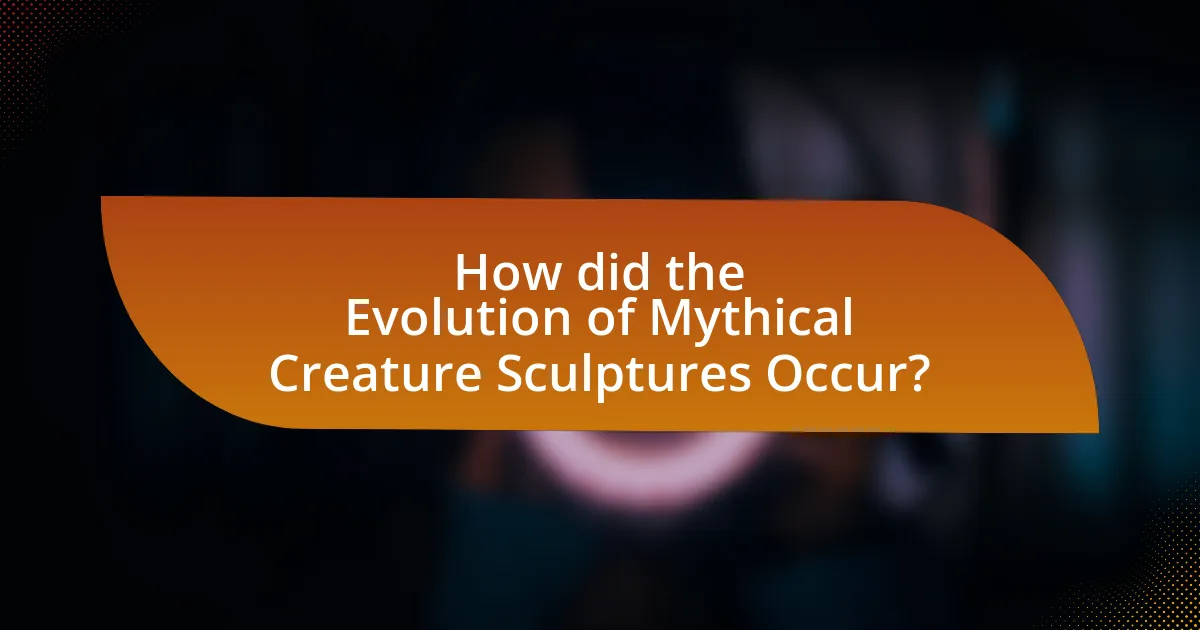
How did the Evolution of Mythical Creature Sculptures Occur?
The evolution of mythical creature sculptures occurred through a combination of cultural beliefs, artistic expression, and technological advancements. Ancient civilizations, such as the Greeks and Egyptians, created sculptures that reflected their mythology and religious practices, often depicting gods, monsters, and hybrid beings. For instance, the Greeks sculpted figures like the Minotaur and centaurs, which symbolized human traits and moral lessons, while the Egyptians crafted sphinxes and other deities to represent power and protection. Over time, the techniques in carving and materials used, such as stone, bronze, and clay, improved, allowing for more intricate and detailed representations. This evolution was also influenced by trade and cultural exchanges, which introduced new ideas and styles, leading to a diverse array of mythical creature sculptures across different regions.
What historical factors influenced the evolution of these sculptures?
The evolution of mythical creature sculptures in ancient cultures was influenced by religious beliefs, cultural exchanges, and socio-political contexts. Religious beliefs often dictated the representation of deities and mythical beings, as seen in ancient Egyptian sculptures that depicted gods like Anubis and Horus, reflecting the society’s spiritual values. Cultural exchanges through trade and conquest introduced new artistic styles and motifs, evident in the Greco-Roman adaptations of earlier Near Eastern art forms. Additionally, socio-political contexts, such as the rise and fall of empires, shaped the themes and purposes of these sculptures, with works often commissioned to convey power or divine favor, as illustrated by the monumental sculptures of the Assyrian Empire that celebrated military victories.
How did trade and cultural exchange impact sculpture styles?
Trade and cultural exchange significantly influenced sculpture styles by facilitating the sharing of artistic techniques and motifs across different civilizations. For instance, the Silk Road enabled the transmission of Hellenistic styles into Central Asia, leading to the incorporation of Greek elements in local sculptures, such as the blending of human and animal forms in mythical creature representations. Additionally, the spread of materials like marble and bronze through trade routes allowed artisans to experiment with new textures and finishes, enhancing the aesthetic quality of sculptures. Historical evidence shows that the introduction of Indian artistic influences into Southeast Asia resulted in the creation of hybrid styles, exemplified by the Khmer sculptures that merged local traditions with Indian iconography.
What role did technological advancements play in sculpture evolution?
Technological advancements significantly influenced the evolution of sculpture by enabling artists to create more intricate and durable works. Innovations such as the development of tools like chisels and hammers allowed for greater precision in carving materials like stone and wood, leading to more detailed representations of mythical creatures. Additionally, the introduction of new materials, such as bronze through the lost-wax casting technique, expanded the possibilities for sculptural forms and allowed for larger and more complex pieces. Historical evidence shows that ancient cultures, such as the Greeks and Egyptians, utilized these advancements to produce iconic sculptures that reflected their mythology and beliefs, demonstrating the direct impact of technology on artistic expression.
How did different cultures interpret mythical creatures in their sculptures?
Different cultures interpreted mythical creatures in their sculptures by reflecting their unique beliefs, values, and environmental contexts. For instance, ancient Greek sculptures often depicted creatures like centaurs and griffins, symbolizing the duality of human nature and the connection between the divine and the earthly. In contrast, Mesopotamian art featured lamassu, hybrid beings with human heads and animal bodies, serving as protective deities at palace entrances, illustrating the culture’s emphasis on guardianship and power. Similarly, in Asian cultures, dragons were sculpted as symbols of strength and good fortune, embodying the harmony between nature and humanity. These interpretations reveal how each culture utilized mythical creatures in sculpture to convey complex narratives and societal ideals, demonstrating the diverse ways in which human imagination interacts with the natural and spiritual worlds.
What variations exist between Eastern and Western representations?
Eastern and Western representations of mythical creatures differ significantly in symbolism, style, and cultural context. In Eastern cultures, such as those in China and India, mythical creatures often embody spiritual or philosophical concepts, like dragons symbolizing power and wisdom, while their artistic representations tend to be intricate and colorful, reflecting harmony with nature. Conversely, Western representations, particularly in Greco-Roman traditions, often focus on individualism and heroism, with creatures like griffins and centaurs depicted in a more realistic and muscular style, emphasizing human-like traits and narratives of conflict. This divergence illustrates how cultural values shape artistic expression, with Eastern art prioritizing balance and spirituality, while Western art emphasizes realism and human experience.
How did local legends shape the depiction of mythical creatures?
Local legends significantly influenced the depiction of mythical creatures by embedding cultural values, fears, and aspirations into their characteristics and narratives. For instance, in ancient Mesopotamia, the legend of the Lamassu, a protective deity depicted as a winged bull or lion with a human head, symbolized strength and protection, reflecting the society’s reverence for power and guardianship. Similarly, in Greek mythology, the Chimera, a fire-breathing creature composed of parts from different animals, represented chaos and the unknown, illustrating the Greeks’ attempts to explain natural phenomena and human fears. These legends not only shaped the physical attributes of the creatures but also their roles in society, as seen in the way they were sculpted in temples and public spaces, serving both decorative and didactic purposes.

What are the Key Examples of Mythical Creature Sculptures?
Key examples of mythical creature sculptures include the griffin from ancient Persia, the sphinx from ancient Egypt, and the dragon from various Asian cultures. The griffin, a creature with the body of a lion and the head and wings of an eagle, symbolizes strength and protection, often found in Persian art and architecture. The sphinx, characterized by a lion’s body and a human head, represents wisdom and guardianship, prominently featured in Egyptian monuments like the Great Sphinx of Giza. Dragons, depicted in various forms across Asian cultures, symbolize power and good fortune, with notable examples in Chinese art, where they are often shown as benevolent creatures associated with water and agriculture. These sculptures reflect the cultural significance and artistic expression of mythical beings in ancient societies.
What are some notable sculptures from ancient civilizations?
Notable sculptures from ancient civilizations include the Great Sphinx of Giza, the Venus of Willendorf, and the Parthenon Marbles. The Great Sphinx, carved during the reign of Pharaoh Khafre around 2500 BCE, represents a mythical creature with a lion’s body and a human head, symbolizing strength and wisdom. The Venus of Willendorf, dating back to approximately 28,000–25,000 BCE, is a small statuette that emphasizes fertility and femininity, showcasing the artistic focus on human form in prehistoric cultures. The Parthenon Marbles, created in the 5th century BCE, include intricate relief sculptures depicting mythological scenes and figures, reflecting the artistic achievements of ancient Greece and their reverence for mythology. These sculptures exemplify the cultural significance and artistic expression of ancient civilizations in relation to mythical themes.
How do the sculptures from Mesopotamia compare to those from Ancient Greece?
Sculptures from Mesopotamia primarily focus on religious and political themes, often depicting gods, mythological creatures, and rulers, while Ancient Greek sculptures emphasize humanism, idealized forms, and the beauty of the human body. Mesopotamian sculptures, such as the Assyrian lamassu, combine human and animal features to convey power and protection, whereas Greek sculptures, like those of the Parthenon, celebrate human anatomy and proportion, reflecting a shift towards realism and individualism. This distinction highlights the cultural values of each civilization: Mesopotamia’s emphasis on divine authority contrasts with Greece’s focus on human experience and aesthetics.
What unique features are found in Egyptian mythical creature sculptures?
Egyptian mythical creature sculptures are characterized by their hybrid forms, combining human and animal features to symbolize various deities and concepts. Notable examples include the sphinx, which merges a lion’s body with a human head, representing strength and wisdom, and the god Anubis, depicted with a jackal’s head and a human body, symbolizing protection and the afterlife. These sculptures often exhibit intricate detailing, such as hieroglyphs and symbolic motifs, which convey religious significance and cultural beliefs. The use of materials like stone and wood, along with techniques such as carving and painting, further enhances their unique aesthetic and spiritual value.
What modern interpretations can be seen in contemporary art?
Modern interpretations in contemporary art often reflect themes of identity, technology, and social commentary. Artists utilize various mediums, such as digital art and installation, to explore these concepts, often drawing inspiration from historical narratives and cultural myths. For instance, the use of mythical creatures in contemporary sculptures can symbolize the intersection of ancient beliefs and modern existential questions, as seen in the works of artists like Kiki Smith and Takashi Murakami, who reinterpret traditional motifs to address contemporary issues. This blending of past and present highlights the ongoing relevance of mythology in understanding human experience today.
How do modern artists draw inspiration from ancient sculptures?
Modern artists draw inspiration from ancient sculptures by studying their forms, techniques, and cultural significance. These artists often analyze the stylistic elements and materials used in ancient works, such as the realistic anatomy of Greek sculptures or the intricate details of Roman reliefs. For instance, contemporary sculptors may replicate the use of marble or bronze, which were prevalent in ancient times, to evoke a sense of timelessness and connection to history. Additionally, themes and motifs from ancient sculptures, such as mythological figures or symbolic representations, are frequently reinterpreted in modern contexts, allowing artists to explore contemporary issues through the lens of historical art. This practice not only honors the craftsmanship of ancient cultures but also fosters a dialogue between past and present artistic expressions.
What themes from ancient sculptures are still relevant today?
Themes from ancient sculptures that remain relevant today include the exploration of human emotion, the representation of mythology, and the celebration of the human form. These themes resonate across cultures and time periods, as they address universal experiences and ideals. For instance, sculptures depicting gods and mythical creatures often symbolize human aspirations and fears, reflecting the same emotional complexities found in contemporary art. Additionally, the emphasis on the human body in ancient sculptures continues to influence modern aesthetics and discussions around beauty, identity, and physicality. The enduring nature of these themes highlights their significance in both historical and modern contexts, demonstrating how ancient artistic expressions continue to inform and inspire current artistic practices and cultural narratives.
What practical insights can be gained from studying these sculptures?
Studying sculptures of mythical creatures provides practical insights into the cultural values, beliefs, and artistic techniques of ancient societies. These sculptures often reflect the mythology and symbolism prevalent in their respective cultures, revealing how societies understood and interpreted the world around them. For instance, the presence of griffins in ancient Persian art signifies the importance of protection and strength, while the depiction of mermaids in various cultures illustrates themes of allure and danger associated with the sea. Additionally, analyzing the materials and methods used in these sculptures can inform modern artists about historical craftsmanship and the evolution of artistic styles, as seen in the transition from clay to bronze in ancient Greek sculptures.
How can understanding ancient sculptures enhance modern artistic practices?
Understanding ancient sculptures can enhance modern artistic practices by providing insights into techniques, materials, and cultural narratives that have shaped artistic expression over centuries. For instance, the use of specific carving techniques seen in ancient Greek and Roman sculptures, such as contrapposto and the application of polychromy, can inform contemporary artists about the physicality and dynamism of form. Additionally, the thematic exploration of mythical creatures in ancient cultures, such as the Sphinx in Egyptian art or the Minotaur in Greek mythology, offers modern artists a rich source of inspiration for storytelling and symbolism in their work. This connection to historical context not only deepens the artist’s understanding of their craft but also fosters a dialogue between past and present, allowing for innovative reinterpretations of traditional motifs.
What lessons can be learned about cultural identity through these artworks?
Artworks depicting mythical creature sculptures reveal significant lessons about cultural identity, particularly how societies express their values, beliefs, and historical narratives. These sculptures often embody the unique characteristics and symbolism of the cultures that created them, reflecting their worldview and societal norms. For instance, ancient Greek sculptures of centaurs illustrate the Greeks’ fascination with the duality of human nature, while Egyptian sphinxes symbolize protection and wisdom, showcasing the importance of these traits in their civilization. Such representations serve as a visual language that communicates cultural stories and collective identities, allowing contemporary audiences to understand the complexities of ancient societies.
